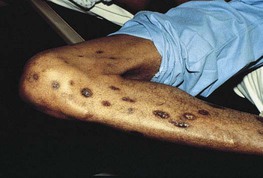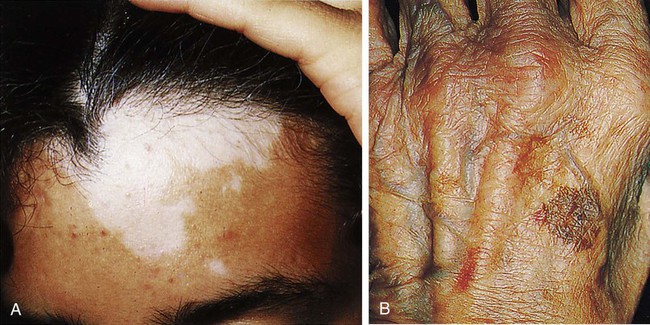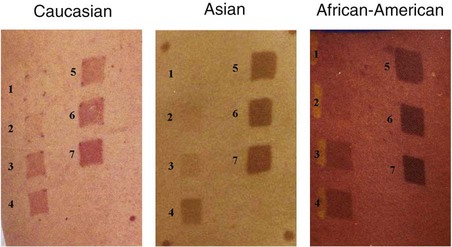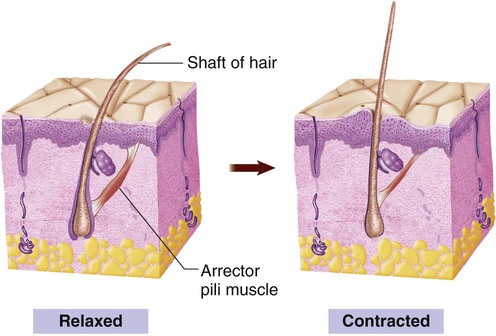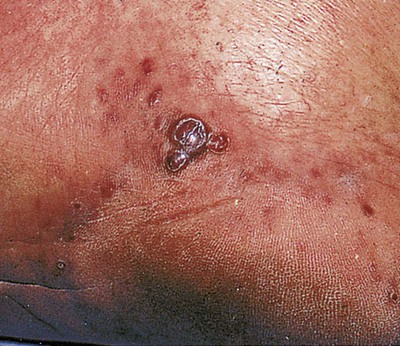Chapter 10 Integumentary System Terminology* *A short transition syllable or vowel may be added to or deleted from the word parts to make the combining form. The integumentary system is composed of the skin and accessory structures (Fig. 10-1). Accessory structures of the system include the hair, nails, specialized glands, and nerves. The main function of the integumentary system is to protect the other body systems from injury and infection. A second function is to help the body maintain homeostasis by regulating temperature, retaining body fluids, and eliminating wastes. The skin also helps to perceive the environment with sensory receptors. The skin stores energy and vitamins and produces vitamin D from sunlight. Some hormones, fat-soluble vitamins, and drugs may be absorbed through the skin. The skin, covering 17 to 20 square feet (1.6 to 1.9 m2), is the largest organ in the body. It varies in thickness from The epidermis, or cuticle, is the outermost layer of the skin and is composed of a surface of dead cells with an underlying layer of living cells. Water-repellent cells made of protein (keratinocytes) make up 90% of the epidermis. Oil (sebaceous) and sweat (sudoriferous) glands and hair follicles lie in the epidermis. Melanocytes, which produce melanin, are located in this layer. Melanin is the pigment that gives skin its color (Fig. 10-3). The surface of the epidermis is covered with a film composed of sweat, oil, and epithelial cells that lubricates, hydrates, provides antibacterial protection, and blocks toxic agents from entering the body. Each hair root originates in the dermis. The visible portion is called the shaft. The hair follicle is the root with its covering. One or two oil (sebaceous) glands are attached to each hair follicle. A tiny muscle (arrector pili) is attached to the hair shaft and causes “goose bumps” or the hair to “stand on end” in response to cold or fear (Fig. 10-4). Hair color and texture are inherited. The color depends on the amount of melanin in the cells. The function of the nails is to protect fingers and toes from injury. Fingernails and toenails are formed from dead, keratinized epidermal cells. The root or area of nail growth is covered by skin at the area of attachment to finger or toe. The crescent-shaped white area near the root is the lunula (Fig. 10-5). Furuncle (FER-ung-kl), commonly called a boil, is a bacterial infection of a hair follicle. Although it is usually caused by Staphylococcus aureus (S. aureus), it may result from other bacteria or fungi. A carbuncle is several boils that join together. Recurring boils may indicate diabetes or an immune disorder. Boils are infectious, but the spread can be controlled with careful cleanliness and handwashing. Treatment includes hot compresses, antibiotics, and sometimes drainage by lancing. Boils may also be caused by methicillin-resistant S. aureus (MRSA). More information about MSRA is found in Chapter 3. Kaposi sarcoma (KS) (kuh-POH-see sahr-KOH-muh) (Fig. 10-6) is a form of cancer that originates in blood vessels and spreads to the skin. KS appears as a round or oval spot on the skin that may be red, purplish, or brown in color. It has two forms. One form affects older people and rarely spreads to other parts of the body. The second form is associated with diabetes, lymphoma, and AIDS. It grows more quickly and may spread to the lungs, liver, and intestines. Treatment for KS may include local treatment, systemic chemotherapy, or interferon.
Integumentary System
 Define at least 10 terms relating to the integumentary system.
Define at least 10 terms relating to the integumentary system.
 Describe the function of the integumentary system.
Describe the function of the integumentary system.
 Identify at least five integumentary system structures and the function of each.
Identify at least five integumentary system structures and the function of each.
 Identify at least three methods used to assess the function of the integumentary system.
Identify at least three methods used to assess the function of the integumentary system.
 Describe at least five disorders of the integumentary system.
Describe at least five disorders of the integumentary system.
 Describe three methods that can be used to maintain healthy skin.
Describe three methods that can be used to maintain healthy skin.
 Identify three types of skin cancer and at least five methods for prevention.
Identify three types of skin cancer and at least five methods for prevention.
Term
Definition
Prefix
Root
Suffix
Cheilorrhaphy
Suture of the lip
cheil/o
rrhaphy
Cutaneous
Pertaining to the skin
cutan
eous
Cyanoderm
Blue skin
cyan/o
derm
Dermatitis
Inflammation of the skin
derm/at
itis
Melanoma
Tumor that is black
melan
oma
Psoriasis
Condition of the skin characterized by itching
psor
iasis
Rhinoplasty
Plastic repair of the nose
rhin/o
plasty
Sarcoma
Tumor of the flesh
sarc
oma
Sebaceous
Pertaining to oil
seb/ac
eous
Stomatitis
Inflammation of the mouth
stoma/t
itis
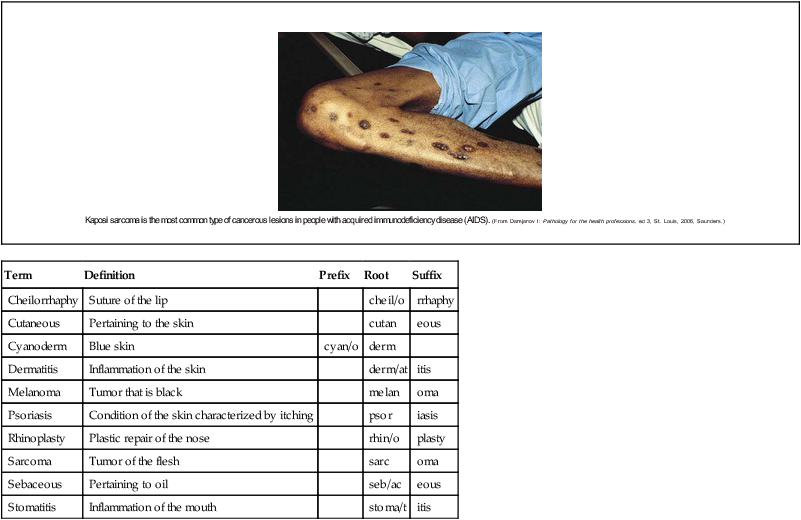
Structure and Function
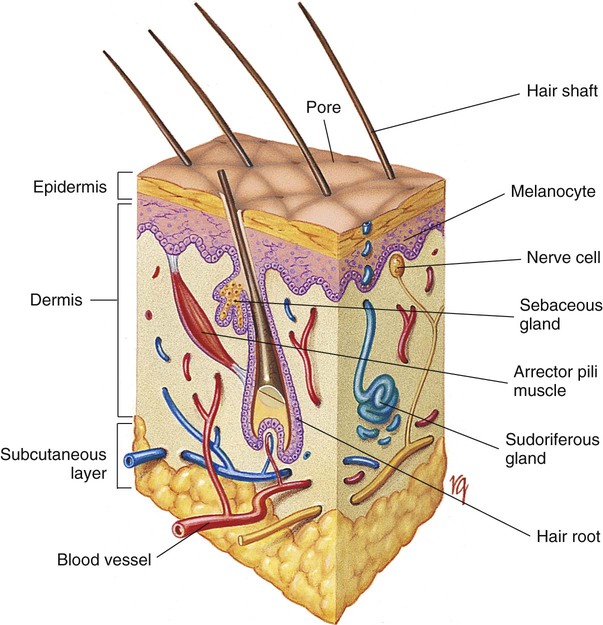
Skin
 inch (0.5 mm) in the eyelids to
inch (0.5 mm) in the eyelids to  inch (6.3 mm) in the soles of the feet. Changes in the skin often indicate the presence of other body system disorders, including anemia, respiratory disorders, liver disorders, cancer, and shock (Fig. 10-2).
inch (6.3 mm) in the soles of the feet. Changes in the skin often indicate the presence of other body system disorders, including anemia, respiratory disorders, liver disorders, cancer, and shock (Fig. 10-2).
Hair and Hair Follicles
Nails
Disorders of the Integumentary System
![]()
Stay updated, free articles. Join our Telegram channel

Full access? Get Clinical Tree


Nurse Key
Fastest Nurse Insight Engine
Get Clinical Tree app for offline access

